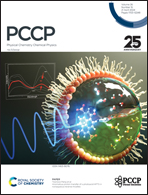Superconductivity in Ca-intercalated bilayer graphene: C2CaC2†
Abstract
The deposition and intercalation of metal atoms can induce superconductivity in monolayer and bilayer graphenes. For example, it has been experimentally proved that Li-deposited graphene is a superconductor with critical temperature Tc of 5.9 K, Ca-intercalated bilayer graphene C6CaC6 and K-intercalated epitaxial bilayer graphene C8KC8 are superconductors with Tc of 2–4 K and 3.6 K, respectively. However, the Tc of them are relatively low. To obtain higher Tc in graphene-based superconductors, here we predict a new Ca-intercalated bilayer graphene C2CaC2, which shows higher Ca concentration than the C6CaC6. It is proved to be thermodynamically and dynamically stable. The electronic structure, electron–phonon coupling (EPC) and superconductivity of C2CaC2 are investigated based on first-principles calculations. The EPC of C2CaC2 mainly comes from the coupling between the electrons of C-pz orbital and the high- and low-frequency vibration modes of C atoms. The calculated EPC constant λ of C2CaC2 is 0.75, and the superconducting Tc is 18.9 K, which is much higher than other metal-intercalated bilayer graphenes. By further applying −4% biaxial compressive strain to C2CaC2, the Tc can be boosted to 26.6 K. Thus, the predicted C2CaC2 provides a new platform for realizing superconductivity with the highest Tc in bilayer graphenes.



 Please wait while we load your content...
Please wait while we load your content...